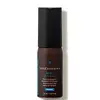What's inside
What's inside
 Key Ingredients
Key Ingredients

 Benefits
Benefits

 Concerns
Concerns

 Ingredients Side-by-side
Ingredients Side-by-side

Water
Skin ConditioningTetrahexyldecyl Ascorbate
AntioxidantCaprylic/Capric Triglyceride
MaskingSodium PCA
HumectantSqualane
Emollient3-O-Ethyl Ascorbic Acid
Skin ConditioningAscorbic Acid
AntioxidantLactic Acid
BufferingCentella Asiatica Extract
CleansingSodium Hyaluronate
HumectantCeramide Ng
Skin ConditioningSuperoxide Dismutase
AntioxidantUbiquinone
AntioxidantPhyllanthus Emblica Fruit Extract
HumectantSaccharide Isomerate
HumectantGlycyrrhiza Glabra Root Extract
BleachingEctoin
Skin ConditioningNiacinamide
SmoothingSoy Isoflavones
Skin ConditioningQuercetin
AntioxidantPhospholipids
Skin ConditioningCaffeine
Skin ConditioningTranexamic Acid
AstringentFerulic Acid
AntimicrobialCarnitine
CleansingAdenosine
Skin ConditioningZinc PCA
HumectantGlycerin
HumectantButylene Glycol
HumectantCaprylyl Glycol
EmollientCaesalpinia Spinosa Gum
Skin ConditioningHectorite
AbsorbentSilica
AbrasiveHdi/Trimethylol Hexyllactone Crosspolymer
Leuconostoc/Radish Root Ferment Filtrate
AntimicrobialPolyacrylate Crosspolymer-6
Emulsion StabilisingCetearyl Olivate
Carbomer
Emulsion StabilisingPotassium Hydroxide
BufferingSorbitan Olivate
EmulsifyingCitric Acid
BufferingPentasodium Pentetate
Potassium Citrate
BufferingPotassium Gluconate
Skin ProtectingPhytic Acid
Phenoxyethanol
PreservativeSorbic Acid
PreservativePotassium Sorbate
PreservativeCI 77891
Cosmetic ColorantWater, Tetrahexyldecyl Ascorbate, Caprylic/Capric Triglyceride, Sodium PCA, Squalane, 3-O-Ethyl Ascorbic Acid, Ascorbic Acid, Lactic Acid, Centella Asiatica Extract, Sodium Hyaluronate, Ceramide Ng, Superoxide Dismutase, Ubiquinone, Phyllanthus Emblica Fruit Extract, Saccharide Isomerate, Glycyrrhiza Glabra Root Extract, Ectoin, Niacinamide, Soy Isoflavones, Quercetin, Phospholipids, Caffeine, Tranexamic Acid, Ferulic Acid, Carnitine, Adenosine, Zinc PCA, Glycerin, Butylene Glycol, Caprylyl Glycol, Caesalpinia Spinosa Gum, Hectorite, Silica, Hdi/Trimethylol Hexyllactone Crosspolymer, Leuconostoc/Radish Root Ferment Filtrate, Polyacrylate Crosspolymer-6, Cetearyl Olivate, Carbomer, Potassium Hydroxide, Sorbitan Olivate, Citric Acid, Pentasodium Pentetate, Potassium Citrate, Potassium Gluconate, Phytic Acid, Phenoxyethanol, Sorbic Acid, Potassium Sorbate, CI 77891
Water
Skin ConditioningDipropylene Glycol
HumectantButylene Glycol
HumectantUndecane
EmollientBis-Hydroxyethoxypropyl Dimethicone
EmollientAlcohol Denat.
AntimicrobialAscorbic Acid
AntioxidantDimethicone
EmollientCaprylic/Capric Triglyceride
MaskingTridecane
PerfumingPhloretin
AntioxidantLauryl PEG-9 Polydimethylsiloxyethyl Dimethicone
Skin ConditioningDimethicone/PEG-10/15 Crosspolymer
Dimethicone/Polyglycerin-3 Crosspolymer
CleansingFerulic Acid
AntimicrobialRuscus Aculeatus Root Extract
AstringentCaffeine
Skin ConditioningDisodium EDTA
Sodium Hydroxide
BufferingWater, Dipropylene Glycol, Butylene Glycol, Undecane, Bis-Hydroxyethoxypropyl Dimethicone, Alcohol Denat., Ascorbic Acid, Dimethicone, Caprylic/Capric Triglyceride, Tridecane, Phloretin, Lauryl PEG-9 Polydimethylsiloxyethyl Dimethicone, Dimethicone/PEG-10/15 Crosspolymer, Dimethicone/Polyglycerin-3 Crosspolymer, Ferulic Acid, Ruscus Aculeatus Root Extract, Caffeine, Disodium EDTA, Sodium Hydroxide
Alternatives
Ingredients Explained
These ingredients are found in both products.
Ingredients higher up in an ingredient list are typically present in a larger amount.
Ascorbic Acid is is pure Vitamin C. This form makes up the largest amount of vitamin C found naturally in our skin.
Not only is vitamin C great for your overall health and immune system, it also has plenty of benefits on your skin.
Vitamin C is best used for brightening skin. It improves dark spots, acne scars, and hyperpigmentation. This is because it blocks the process of skin darkening when exposed to UV.
Remember: Vitamin C should not replace sunscreen!
Your skin uses vitamin C to build collagen. Collagen is one key component in having a strong skin barrier and plump skin. Vitamin C also plays a role in regulating collagen, thus making it effective in improving wrinkles and fine lines.
Ascorbic acid shows potent antioxidant activity. As an antioxidant, it helps fight free-radicals. Free-radicals are molecules that may damage your skin cells. These antioxidants also protect skin against UV damage.
The best formulations include Vitamin E and/or ferulic acid. These two ingredients help stabilize and provide a boost in the benefits of ascorbic acid. This is because ascorbic acid becomes unstable when exposed to UV and air. In fact, you can tell your ascorbic acid has oxidized when it turns an orange-yellow color.
Ascorbic acid is generally compatible with other ingredients. However, using ascorbic acid with other active ingredients might cause irritation. Two ingredients: copper ions and benzoyl peroxide, will inactivate ascorbic acid completely.
Read more about other types of Vitamin C:
Foods rich with vitamin C include oranges, strawberries, broccoli, bell peppers, and more. When consuming Vitamin C, your skin receives a portion of the nutrients.
Learn more about Ascorbic AcidButylene Glycol (or BG) is used within cosmetic products for a few different reasons:
Overall, Butylene Glycol is a safe and well-rounded ingredient that works well with other ingredients.
Though this ingredient works well with most skin types, some people with sensitive skin may experience a reaction such as allergic rashes, closed comedones, or itchiness.
Learn more about Butylene GlycolCaffeine is most associated with coffee, tea, and cacao. In skincare, it helps with calming inflammation and is rich in antioxidants.
While caffeine is used to treat cellulite and and dark circles, further studies are needed to prove this. It has been believed to help with these skin conditions due to its ability to dilate blood vessels and increase blood flow.
Some studies are looking into caffeine's ability to protect against UV rays.
Learn more about CaffeineThis ingredient is an emollient, solvent, and texture enhancer. It is considered a skin-softener by helping the skin prevent moisture loss.
It helps thicken a product's formula and makes it easier to spread by dissolving clumping compounds.
Caprylic Triglyceride is made by combining glycerin with coconut oil, forming a clear liquid.
While there is an assumption Caprylic Triglyceride can clog pores due to it being derived from coconut oil, there is no research supporting this.
Learn more about Caprylic/Capric TriglycerideFerulic Acid is a plant based antioxidant. By fighting free-radicals, ferulic acid can help reduce the formation of fine lines and hyperpigmentation.
When used with Vitamin C, Ferulic Acid has shown to prevent Vitamin C from breaking down. In other words, it acts as a stabilizer.
Ferulic Acid is sometimes used to preserve food. Foods containing Ferulic Acid include: oats, rice, eggplant, citrus.
In medicine, Ferulic Acid is being studied for helping with diabetes, Alzheimer's, and cardiovascular diseases.
Learn more about Ferulic AcidWater. It's the most common cosmetic ingredient of all. You'll usually see it at the top of ingredient lists, meaning that it makes up the largest part of the product.
So why is it so popular? Water most often acts as a solvent - this means that it helps dissolve other ingredients into the formulation.
You'll also recognize water as that liquid we all need to stay alive. If you see this, drink a glass of water. Stay hydrated!
Learn more about Water